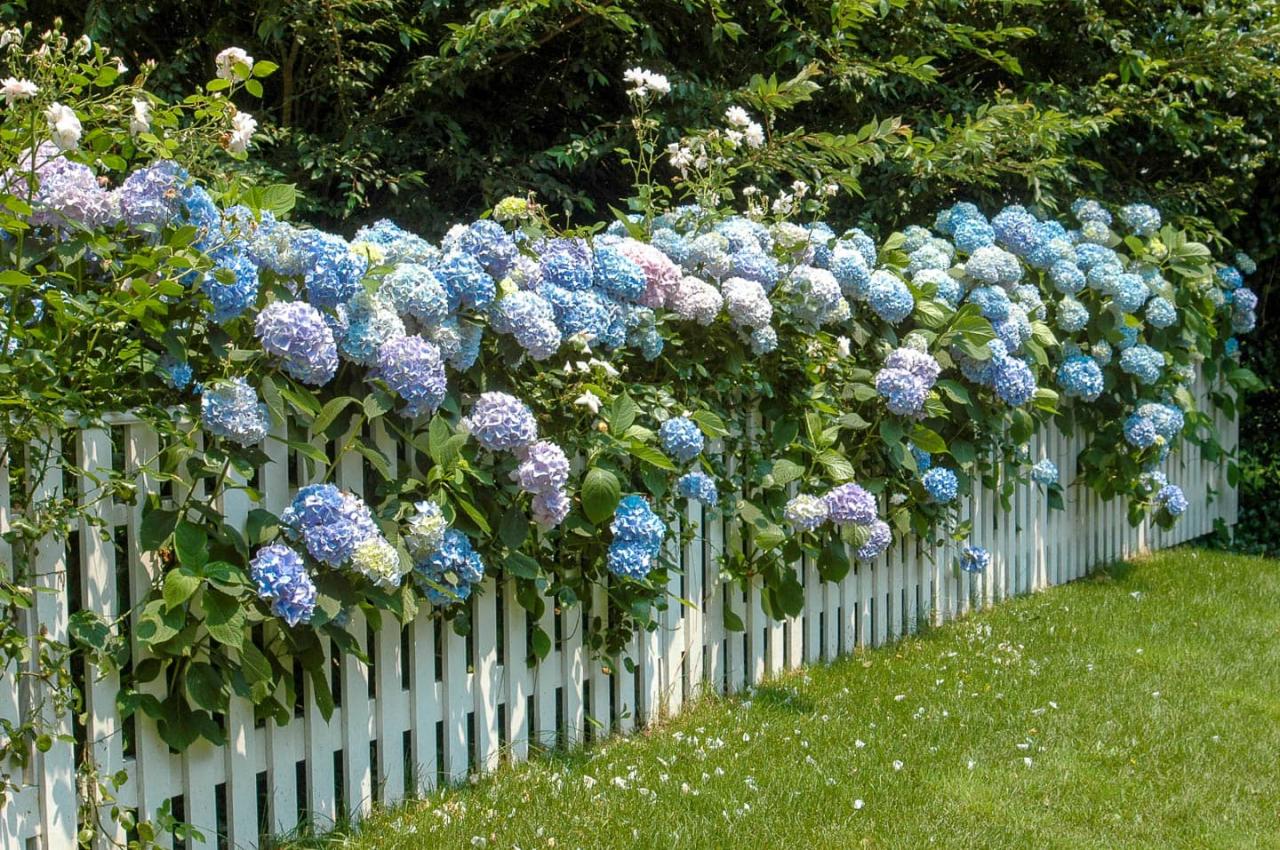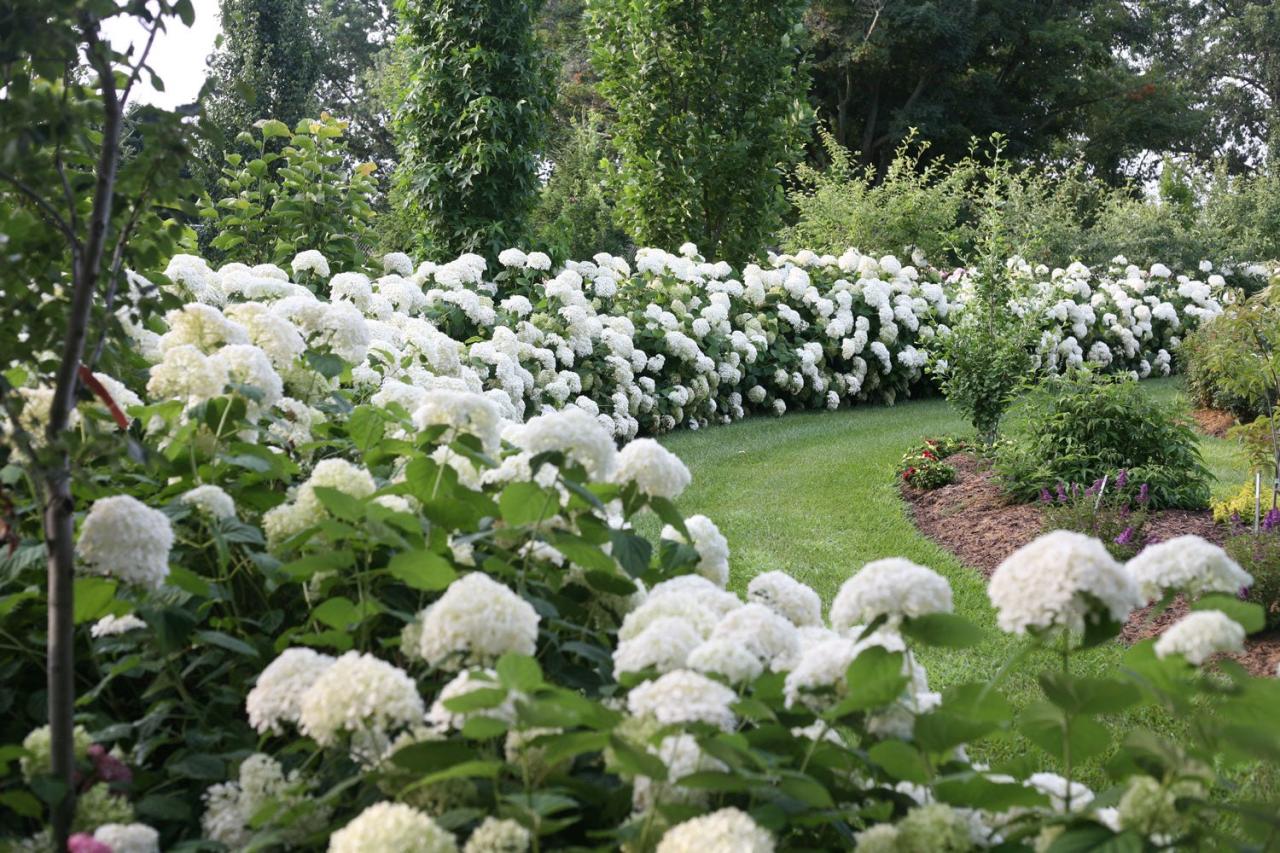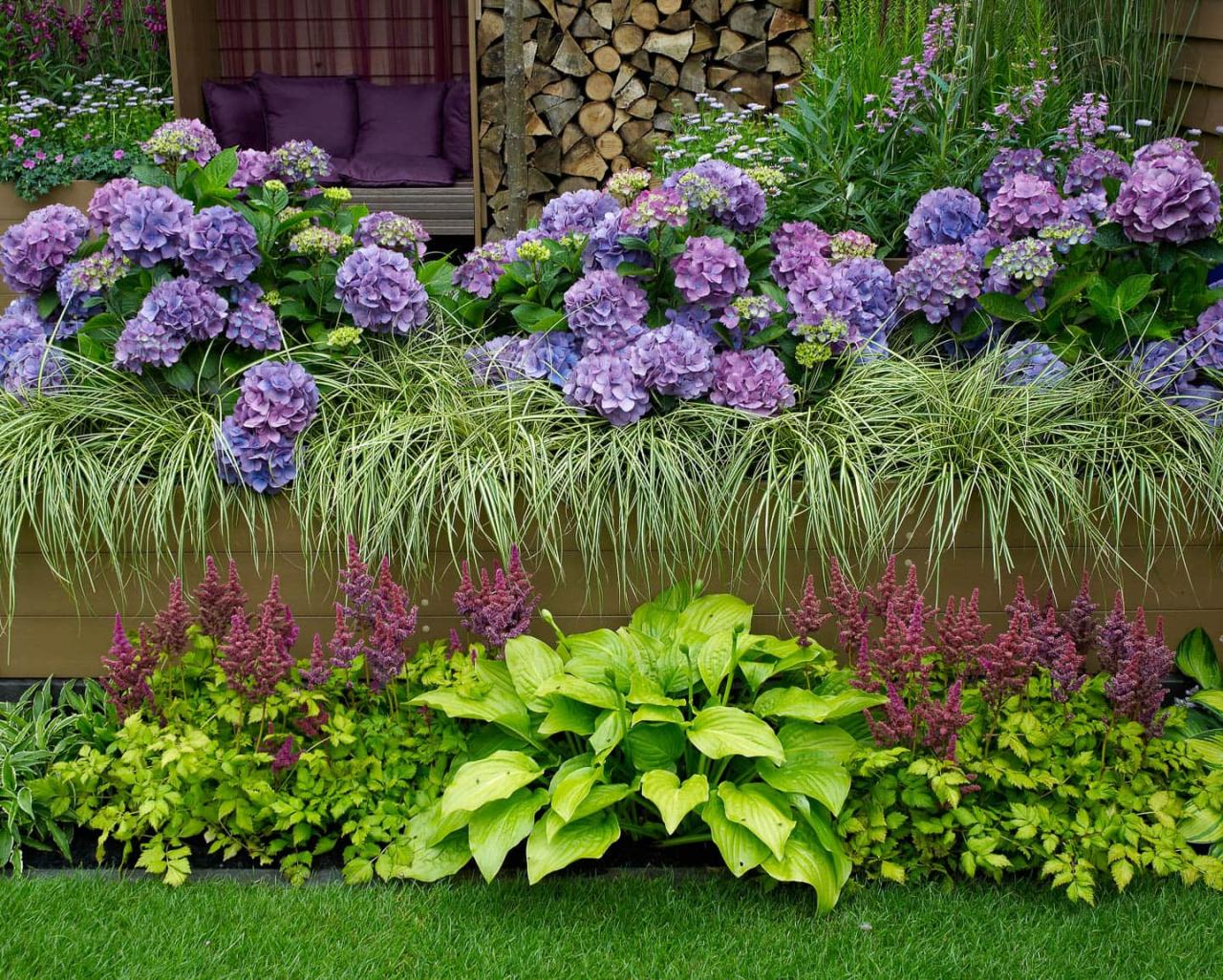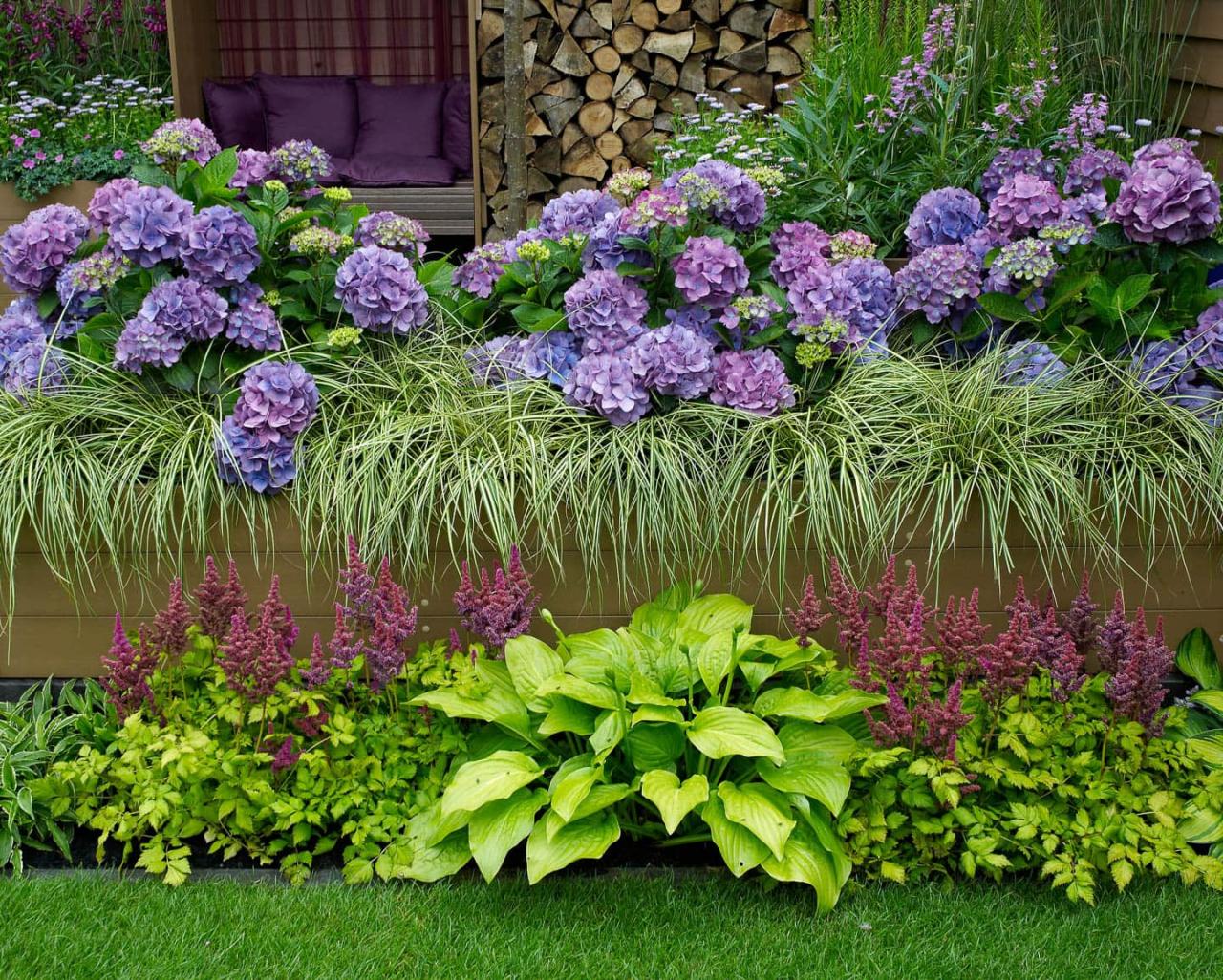How to Create a Hydrangea Hedge With Beautiful Companion Plants – Transform your garden into a vibrant sanctuary with a stunning hydrangea hedge, enhanced by the beauty of complementary companion plants. This guide will walk you through every step, from selecting the perfect hydrangeas to choosing the ideal companion plants that create a symphony of colors, textures, and growth habits.
Learn how to plan, plant, and maintain your hydrangea hedge, ensuring it thrives and becomes a captivating focal point in your landscape.
From the initial planning stages, we’ll explore the nuances of selecting hydrangea varieties, considering their bloom color, size, and growth habits. We’ll then delve into the art of designing your hedge, incorporating curves, corners, or straight lines to seamlessly integrate it into your garden’s existing landscape.
This comprehensive guide will equip you with the knowledge to create a flourishing hydrangea hedge that will be the envy of your neighborhood.
Planning the Hedge
A well-planned hydrangea hedge can be a stunning focal point in your garden, providing vibrant color and texture throughout the growing season. To ensure your hedge thrives and achieves the desired effect, careful planning is essential.
Determining Ideal Spacing
Spacing hydrangea plants appropriately is crucial for their healthy growth and the overall appearance of the hedge. Consider the mature size of the chosen hydrangea variety when determining spacing. For instance, if you’re using a variety that reaches 6 feet tall and 4 feet wide at maturity, allow 4 to 5 feet of space between each plant to prevent overcrowding and competition for resources.
Designing the Layout
The layout of your hydrangea hedge should complement the existing garden design and personal preferences. Consider these options:
- Straight Lines:A straight hedge can create a formal and structured look, perfect for framing a pathway or dividing garden areas.
- Curves:A curved hedge can add a softer and more natural feel, blending seamlessly with existing landscaping.
- Corners:A hedge can soften sharp corners in your garden, creating a more inviting atmosphere.
Integrating the Hedge into the Landscape
Integrating the hydrangea hedge into the existing landscape requires considering its mature height and width.
- Height:Choose a hydrangea variety that will complement the existing plants and structures in your garden. A tall hedge can create a privacy screen or a backdrop for other plants.
- Width:Plan for the hedge’s mature width, ensuring it doesn’t overwhelm the surrounding landscape. Consider using other plants as companions to create a harmonious balance.
Planting the Hydrangea Hedge
Planting your hydrangea hedge is an exciting step in creating a beautiful and vibrant landscape feature. Proper planting techniques are essential for ensuring the health and success of your hedge. By following these steps, you can give your hydrangeas the best possible start in their new home.
Soil Preparation
Preparing the soil is crucial for hydrangeas to thrive. Hydrangeas prefer slightly acidic soil with good drainage. To prepare the soil, remove any weeds or debris from the planting area. Then, work in a layer of organic matter, such as compost or peat moss, to improve soil structure and drainage.
This will also help to provide essential nutrients for the hydrangeas. You can also test your soil pH and amend it if necessary.
Digging Holes
Dig holes that are twice as wide as the root ball of the hydrangeas and the same depth. This allows for ample space for the roots to spread and grow. Ensure the spacing between the holes is appropriate for the specific hydrangea variety you have chosen.
Generally, hydrangeas need 3-5 feet of space between plants for optimal growth.
Proper Placement
Choose a location that receives at least 4-6 hours of sunlight per day. Hydrangeas prefer morning sun and afternoon shade, especially in warmer climates. Avoid planting them in areas that are prone to strong winds, as this can damage their delicate blooms.
When positioning the plants, make sure they are planted at the same level as they were in the container. This ensures that the roots are not buried too deep.
Watering After Planting
Water the hydrangeas thoroughly after planting to help them establish their root systems. Deep watering is essential, especially during the first year after planting. During the establishment period, it is important to water the hydrangeas regularly, especially during dry spells.
A good rule of thumb is to water them deeply once a week, allowing the water to soak into the soil.
Using Stakes or Supports
Newly planted hydrangeas may need some support to help them grow upright and establish strong root systems. Use stakes or other supports to help guide the plants as they grow. Stake them carefully to avoid damaging the stems.
Remove the stakes once the plants have established themselves.
Companion Plants for Hydrangeas

Adding companion plants to your hydrangea hedge can create a visually appealing and diverse landscape. Companion plants provide contrasting colors, textures, and growth habits, enhancing the beauty of your hydrangea hedge and adding depth and interest to your garden.
Choosing the Right Companion Plants
When selecting companion plants for your hydrangea hedge, consider the following factors:
- Sun Requirements:Ensure the companion plants have similar sun requirements as hydrangeas, which typically prefer partial shade.
- Bloom Times:Choose companion plants that bloom at different times to provide continuous color throughout the growing season.
- Mature Sizes:Select companion plants that complement the size and shape of your hydrangea hedge, avoiding plants that will overpower or crowd them.
- Growth Habits:Consider the growth habits of companion plants, such as spreading, upright, or trailing, to create a balanced and visually appealing hedge.
Companion Plant Examples
Here is a table showcasing various companion plants that complement hydrangeas in terms of color, texture, and growth habits:
Companion Plant |
Sun Requirements |
Bloom Time |
Mature Size |
Growth Habit |
Color |
Texture |
|---|---|---|---|---|---|---|
Astilbe |
Partial shade |
Early summer |
2-3 feet tall |
Upright |
Pink, red, white, purple |
Feathery |
Hosta |
Partial shade |
Late spring to early summer |
1-4 feet tall |
Mounding |
Green, blue-green, variegated |
Textured, large leaves |
Heuchera (Coral Bells) |
Partial shade |
Late spring to early fall |
1-2 feet tall |
Mounding |
Red, orange, yellow, purple, green |
Textured, lobed leaves |
Ferns |
Partial shade |
Spring to fall |
1-4 feet tall |
Upright, spreading |
Green, bronze |
Delicate, lacy foliage |
Rodgersia |
Partial shade |
Mid-summer |
3-5 feet tall |
Upright |
Green, bronze |
Large, bold leaves |
Foxglove |
Partial shade |
Late spring to early summer |
2-4 feet tall |
Upright |
Purple, pink, white, yellow |
Tall, tubular flowers |
Japanese Anemone |
Partial shade |
Late summer to fall |
2-3 feet tall |
Upright |
White, pink, purple |
Dainty, delicate flowers |
Integrating Companion Plants
Companion plants can be integrated into the hydrangea hedge in various ways to create visual interest and diversity.
- Layer Planting:Create layers of different heights and textures by planting taller companion plants like astilbe or ferns behind hydrangeas, with shorter plants like hosta or heuchera in front.
- Color Contrast:Use companion plants with contrasting colors to highlight the beauty of the hydrangeas. For example, pair pink hydrangeas with purple foxgloves or white hydrangeas with red heuchera.
- Textural Variety:Add textural interest by combining smooth hydrangea leaves with the textured foliage of ferns or hostas. This creates a visually appealing contrast and adds depth to the hedge.
- Bloom Time Succession:Choose companion plants that bloom at different times to provide continuous color throughout the growing season. For example, plant Japanese anemones, which bloom in late summer, alongside hydrangeas that bloom in early summer.
Maintaining the Hydrangea Hedge

A hydrangea hedge requires regular maintenance to keep it healthy, attractive, and thriving. This includes pruning, fertilizing, and general upkeep. Proper maintenance will ensure that your hedge remains a beautiful focal point in your garden for years to come.
Creating a hydrangea hedge is a beautiful way to add privacy and color to your garden. While hydrangeas are relatively low-maintenance, they can be susceptible to pests, so it’s important to be proactive in keeping them healthy. For instance, you might want to consider the same pest-prevention techniques used for popular houseplants like the money plant, as detailed in this helpful guide: Money Plant Care: How To Keep Pests Away.
By taking the necessary precautions, you can ensure your hydrangea hedge thrives and remains a stunning focal point in your landscape.
Pruning Hydrangeas for Optimal Growth and Flowering
Pruning hydrangeas is essential for shaping the hedge and encouraging healthy growth and abundant blooms. The best time to prune hydrangeas depends on the type of hydrangea you are growing.
- For mophead and lacecap hydrangeas, which bloom on old wood, prune in late winter or early spring before new growth emerges. This allows you to shape the hedge and remove any dead or diseased branches while ensuring that you don’t prune off the flower buds that will produce blooms later in the season.
- For panicle hydrangeas, which bloom on new wood, prune in late winter or early spring. These hydrangeas benefit from a more drastic pruning, which can be done by cutting back the branches by about one-third. This encourages vigorous new growth and abundant blooms. You can also prune panicle hydrangeas in late summer after they have finished flowering to remove spent flower heads and encourage a more compact shape.
When pruning hydrangeas, use sharp, clean pruning shears. Make clean cuts just above a bud or leaf node. Avoid making ragged or torn cuts, as these can leave the plant vulnerable to disease. For shaping the hedge, prune to the desired height and width, removing any branches that are growing out of bounds.
Regular pruning can also help to prevent the hedge from becoming too dense, which can lead to poor air circulation and an increased risk of disease.
Fertilizing Hydrangeas for Healthy Growth and Vibrant Blooms
Hydrangeas are heavy feeders and benefit from regular fertilization. Fertilize your hydrangea hedge in early spring, before new growth emerges, and again in mid-summer, after the first flush of blooms. Use a balanced fertilizer, such as 10-10-10, or a fertilizer specifically formulated for hydrangeas.
Avoid over-fertilizing, as this can lead to excessive leaf growth at the expense of blooms.
When fertilizing, apply the fertilizer evenly around the base of the hedge, being careful not to get it on the leaves or stems.
Addressing Common Hydrangea Issues

While hydrangeas are generally hardy plants, they can be susceptible to certain pests, diseases, and environmental challenges. Understanding these issues and implementing preventive measures can help ensure the health and vibrancy of your hydrangea hedge.
Pests and Diseases
Hydrangeas are relatively pest-resistant, but they can be targeted by specific insects and fungal diseases. Early identification and treatment are crucial for preventing widespread damage.
- Aphids:These tiny, sap-sucking insects can cause leaf curling, stunted growth, and honeydew production.
- Prevention:Encourage beneficial insects like ladybugs and lacewings, which prey on aphids.
- Treatment:Use a strong jet of water to dislodge aphids or apply insecticidal soap.
- Spider Mites:These microscopic pests feed on plant sap, causing yellowing and browning of leaves.
- Prevention:Maintain adequate humidity levels around the plants.
- Treatment:Use a miticide or horticultural oil to control spider mite populations.
- Powdery Mildew:This fungal disease appears as a white, powdery coating on leaves and stems, hindering photosynthesis.
- Prevention:Provide good air circulation around plants and avoid overhead watering.
- Treatment:Apply a fungicide specifically formulated for powdery mildew.
- Leaf Spot:Various fungal pathogens can cause leaf spot, characterized by brown or black spots on leaves.
- Prevention:Remove and dispose of infected leaves to prevent the spread of disease.
- Treatment:Apply a fungicide labeled for leaf spot.
Watering
Hydrangeas require consistent moisture, especially during periods of drought. Proper watering is essential for healthy growth and abundant blooms.
- Watering Frequency:Water deeply and thoroughly, allowing the soil to dry slightly between waterings. During hot, dry weather, watering may be required more frequently.
- Mulching:Apply a layer of organic mulch around the base of the plants to help retain moisture and suppress weeds.
- Drip Irrigation:Consider using a drip irrigation system to deliver water directly to the root zone, minimizing water loss through evaporation.
Soil pH
The pH of the soil plays a crucial role in determining the color of hydrangea blooms. Acidic soils (pH below 6.0) produce blue blooms, while alkaline soils (pH above 6.5) result in pink or red blooms.
Creating a hydrangea hedge is a fantastic way to add beauty and privacy to your garden. While hydrangeas are stunning on their own, incorporating companion plants can enhance the visual appeal and create a more dynamic landscape. For instance, consider incorporating a small, carefully pruned bonsai tree, like those found on Bonsai , to add a touch of elegance and a focal point to your hedge.
The contrasting textures and colors of the bonsai with the hydrangeas will create a visually interesting and harmonious composition.
- Soil Testing:Use a soil test kit to determine the pH of your soil.
- Example:A soil test reveals a pH of 7.0, indicating alkaline soil. To encourage blue blooms, the soil pH needs to be lowered.
- Acidifying the Soil:To lower the pH, apply aluminum sulfate or iron sulfate to the soil. Follow the product instructions for dosage and application.
- Example:For a soil test result of 7.0, apply 1 cup of aluminum sulfate per 100 square feet of soil.
Creating a hydrangea hedge involves careful consideration of companion plants that thrive in similar conditions. Hydrangeas prefer moist, well-drained soil and partial shade, so choosing plants that share these preferences is key. For instance, if you’re looking to add a touch of greenery and vibrant color, consider the money plant, also known as the Chinese evergreen.
This versatile plant can tolerate various light conditions and thrives in both indoor and outdoor environments. How To Care For A Money Plant In Different Climates will guide you on how to ensure its health and beauty, regardless of your climate.
When paired with hydrangeas, the money plant’s lush foliage creates a striking contrast, adding depth and texture to your hedge.
- Example:For a soil test result of 7.0, apply 1 cup of aluminum sulfate per 100 square feet of soil.
- Maintaining Soil pH:Regularly monitor the soil pH and adjust it as needed to maintain the desired bloom color.
Inspiration and Examples: How To Create A Hydrangea Hedge With Beautiful Companion Plants
Visualizing the final outcome of your hydrangea hedge can help you choose the right hydrangea varieties and companion plants. These examples provide inspiration for your own garden design, showcasing the harmonious blend of color, texture, and form that can be achieved with hydrangeas and their complementary companions.
Examples of Hydrangea Hedges with Companion Plants, How to Create a Hydrangea Hedge With Beautiful Companion Plants
These examples illustrate how different hydrangea species and companion plants can be combined to create a visually stunning and diverse hedge.
- Example 1: A Classic Combination
Imagine a vibrant hydrangea hedge featuring the popular ‘Annabelle’ hydrangea, known for its large, snowball-shaped white blooms. Interspersed among the hydrangeas, you could plant ‘Goldflame’ spirea, with its golden foliage and bright pink blooms, adding a contrasting splash of color.
The spirea’s upright, arching growth habit complements the rounded form of the hydrangeas, creating a dynamic and balanced effect. This combination provides a vibrant contrast of white and pink, while the spirea’s golden foliage adds warmth and texture to the hedge.
- Example 2: A Serene and Subtle Look
For a more subdued and serene aesthetic, consider a hedge of ‘Endless Summer’ hydrangeas, known for their beautiful blue or pink blooms depending on the soil pH. Interplant these hydrangeas with the graceful ‘Blue Angel’ hosta, which boasts blue-green foliage and white flowers that add a touch of elegance.
The hosta’s foliage provides a lush, textural contrast to the hydrangea blooms, creating a soothing and tranquil effect. This combination creates a calming, cool-toned hedge with a blend of blue, white, and green hues.
- Example 3: A Bold and Dramatic Statement
For a dramatic and eye-catching hedge, consider using ‘Pee Gee’ hydrangea, known for its large, conical flower heads that turn a deep pink in autumn. Interplant these hydrangeas with the striking ‘Black Knight’ barberry, with its deep purple foliage and red berries.
The barberry’s dark foliage provides a dramatic backdrop for the hydrangea blooms, creating a striking contrast. This combination creates a bold and dramatic hedge with a vibrant interplay of pink, purple, and red.
Tips for Creating a Similar Look
Here are some key tips to help you replicate these stunning hydrangea hedge designs in your own garden:
- Consider the Size and Shape of the Hydrangeas and Companion Plants: Choose plants that complement each other in terms of size and growth habit. For example, if you have a tall, narrow space, you might choose a columnar hydrangea variety and a taller companion plant like a fern or a spirea.
- Choose Plants with Complementary Colors: Consider the colors of the hydrangea blooms and the foliage of the companion plants. You can create a harmonious look by choosing plants with colors that complement each other, or you can create a bold statement by choosing plants with contrasting colors.
- Think About Texture: The texture of the foliage can also add interest to your hedge. For example, you could combine hydrangeas with plants that have smooth, glossy leaves, textured leaves, or feathery foliage.
- Consider the Bloom Time of the Companion Plants: Choose companion plants that will bloom at different times of the year to provide continuous interest in your hedge. This will ensure that your hedge is always visually appealing, even when the hydrangeas are not in bloom.
Concluding Remarks
Creating a hydrangea hedge with beautiful companion plants is an investment in both beauty and longevity. By following these steps, you’ll be able to design and cultivate a thriving hedge that adds visual interest and enhances your garden’s overall aesthetic.
Remember to select the right hydrangea varieties, choose complementary companion plants, and maintain your hedge with care to enjoy its vibrant blooms and lush foliage for years to come.
Helpful Answers
How often should I water my hydrangea hedge?
Hydrangeas prefer consistently moist soil, especially during the first year after planting. Water deeply and thoroughly, allowing the soil to dry slightly between waterings.
What is the best way to prune my hydrangea hedge?
The best time to prune hydrangeas for shaping is in late winter or early spring, before new growth emerges. Prune to remove dead or diseased branches and shape the hedge to your desired size.
What type of fertilizer should I use for my hydrangeas?
Use a balanced fertilizer formulated for flowering shrubs, applying it in spring and early summer. Avoid over-fertilizing, as this can lead to excessive foliage growth and fewer blooms.
